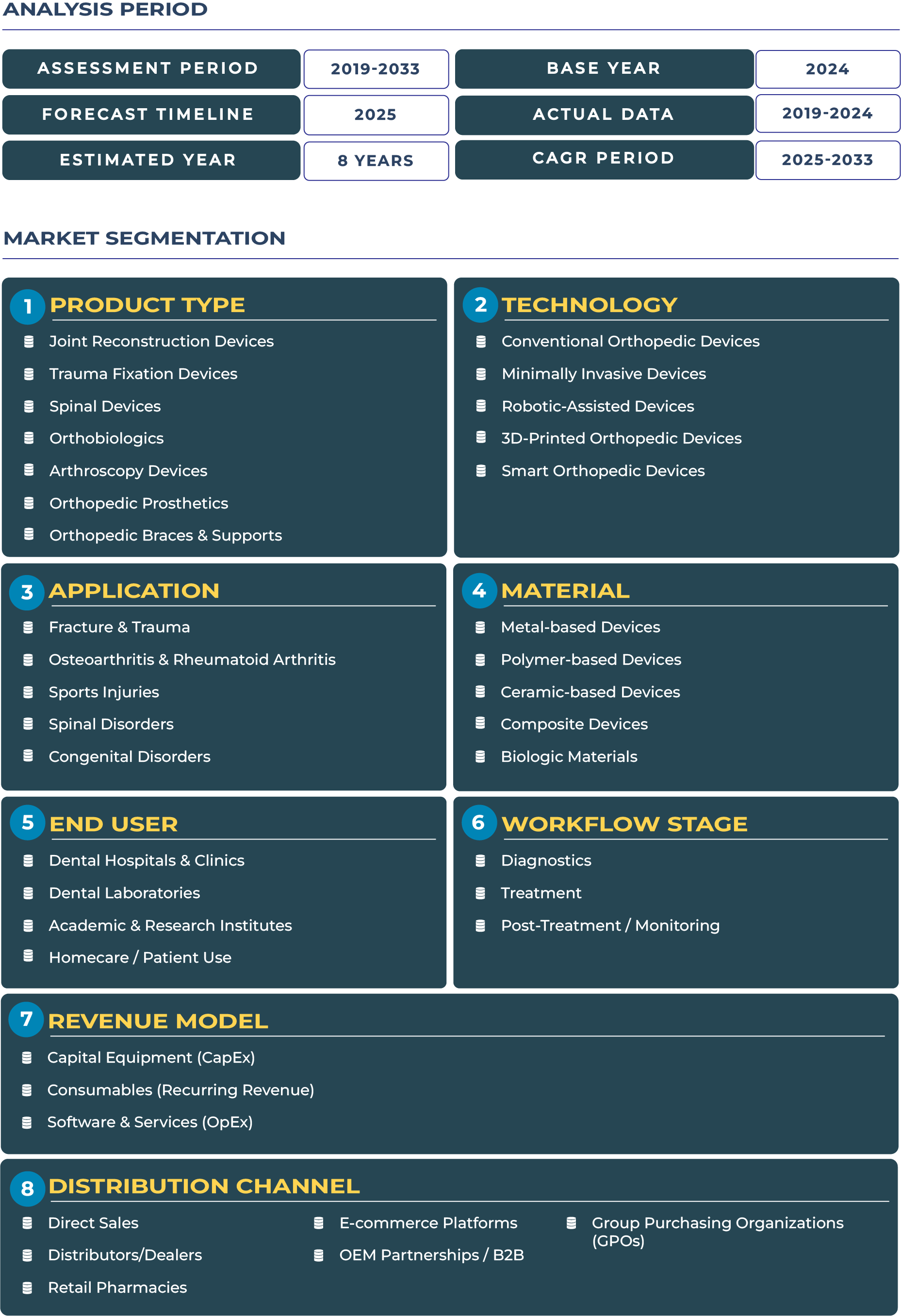Eastern Europe Orthopedic Devices Market Outlook: Emerging Healthcare Modernization Shaping Orthopedic Devices Demand
The Eastern Europe orthopedic devices market is experiencing steady momentum, driven by modernization of healthcare infrastructure, policy reforms, and growing adoption of cost-efficient implants. Valued at USD 2.27 billion in 2025, the sector is projected to reach USD 3.11 billion by 2033, expanding at a CAGR of 4.0% between 2025 and 2033. This performance is underpinned by rising joint replacement surgeries in urban hospitals, increasing demand for trauma fixation in accident-prone regions, and gradual adoption of spinal devices for degenerative disorders among aging populations. Additionally, improved tender frameworks and government-backed initiatives are enabling affordable orthopedic prosthetics to penetrate rural areas, addressing unmet needs. Despite geopolitical tensions, currency volatility, and fluctuating import duties, the market outlook remains positive due to consistent demand in critical care settings and private hospital expansions across Poland, Russia, and other regional hubs.
Eastern Europe Orthopedic Devices Market: Modernization of Healthcare Unlocks New Opportunities
The modernization of healthcare systems in Eastern Europe is reshaping the orthopedic devices market, supported by rising investments in infrastructure, medical technology, and government tenders. Countries across the region are upgrading hospital networks, expanding trauma care facilities, and implementing digital health integration to improve patient outcomes. This transition toward modernized healthcare delivery is generating steady demand for advanced orthopedic implants and surgical instruments, especially in high-need areas such as trauma fixation, spinal stabilization, and joint reconstruction. With healthcare affordability programs playing a crucial role, the orthopedic devices industry is seeing rising procurement through bulk tenders and public-private partnerships, creating growth avenues for local manufacturers and multinational players.
Drivers & Restraints: Balancing Demand and Structural Challenges in Orthopedic Procurement
Unmet Demand and Rising Private Investment Driving Growth
The orthopedic devices market in Eastern Europe benefits from large unmet demand in rural and semi-urban areas, where trauma and joint disorders often remain untreated due to limited access to advanced care. Governments are increasingly relying on competitive tenders to procure implants and devices at scale, reducing cost barriers for public hospitals. In parallel, private hospital chains are investing in surgical robotics, arthroscopy solutions, and advanced trauma fixation systems, accelerating patient adoption. Foreign direct investments in healthcare facilities and partnerships with global medtech companies are further boosting device availability in markets such as Poland and Romania. This synergy of affordability, modernization, and rising private participation is supporting the market’s expansion across diverse sub-segments.
Currency Volatility and Regulatory Bottlenecks Hindering Growth
On the restraint side, currency fluctuations continue to affect import-driven orthopedic procurement, making advanced devices less affordable for smaller hospitals. In addition, fragmented payer ecosystems and inconsistent reimbursement structures across Eastern European nations delay timely adoption of innovative implants. Regulatory bottlenecks in device registration create further challenges, as varying certification timelines across countries slow down market entry for manufacturers. Political instability and ongoing regional conflicts also disrupt supply chains, impacting cross-border distribution of orthopedic prosthetics and surgical implants. These hurdles collectively highlight the need for harmonized regulatory policies, streamlined registration pathways, and better financing mechanisms to unlock the market’s full potential.
Trends & Opportunities: Shaping the Future of Orthopedic Devices Ecosystem
Private Hospital Expansion and Medical Tourism Driving Adoption
Private hospital chains are aggressively expanding in Eastern Europe, particularly in metropolitan cities such as Warsaw, Prague, and Moscow. These institutions are investing in minimally invasive orthopedic surgery facilities and introducing arthroscopy devices that reduce recovery times. Another trend shaping the landscape is medical tourism, with patients from Western Europe and the Middle East seeking cost-effective joint replacement and spinal surgeries in Eastern Europe. This has increased demand for high-quality implants and advanced surgical navigation systems. In addition, donor-led healthcare aid programs in countries with underfunded systems are supporting the procurement of trauma fixation kits and orthobiologics, broadening market opportunities.
Low-Cost Implant Manufacturing and Regional Distribution Hubs Unlocking Opportunities
Manufacturing opportunities are also emerging, with Eastern European companies focusing on low-cost orthopedic implant production to serve both domestic and export markets. Regional distribution hubs in Poland and Hungary are strengthening the supply chain, improving availability of joint reconstruction devices and prosthetics. Additionally, multinational players are sponsoring surgeon training programs in key cities, ensuring proper usage of advanced implants and fostering long-term adoption. This ecosystem of training, localized manufacturing, and strategic distribution is expected to enhance patient access to affordable orthopedic solutions and create a competitive edge for regional players in the global orthopedic devices sector.
Regional Analysis by Country
-
Russia
Russia Orthopedic Devices market is expanding due to high demand for trauma fixation devices and spinal implants, driven by rising road accidents and aging demographics. Government procurement initiatives and localized implant manufacturing are improving affordability. However, geopolitical tensions and currency volatility are impacting import-heavy categories like arthroscopy systems and advanced prosthetics.
-
Poland
Poland has become a strategic hub for orthopedic device distribution in Eastern Europe, supported by EU integration and medical tourism growth. Joint reconstruction and prosthetic devices are seeing high adoption in both public and private hospitals. The market is also benefiting from favorable investment policies, increasing foreign collaborations, and growing demand for minimally invasive procedures.
Competitive Landscape: Local Partnerships and Cost-Effective Solutions Fuel Growth
The competitive landscape in the Eastern Europe orthopedic devices sector is shaped by international leaders such as Stryker alongside regional companies that focus on cost-effective implant manufacturing. Multinationals are introducing affordable implant lines specifically tailored to public hospital budgets, while regional firms leverage distributor partnerships to reduce regulatory hurdles and expand reach. Recent developments include collaborations for surgeon training in Warsaw and Moscow, enabling knowledge transfer and improved adoption of advanced arthroscopy devices. Cost-efficient prosthetics and orthobiologics are being launched by local manufacturers, positioning them competitively in tender-driven procurement models. With both global and regional players adopting strategies around pricing, training, and partnerships, the orthopedic devices industry in Eastern Europe is set for dynamic evolution over the forecast period.








